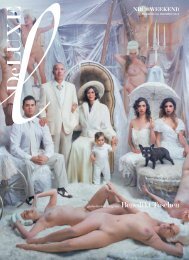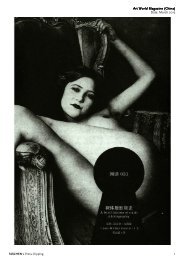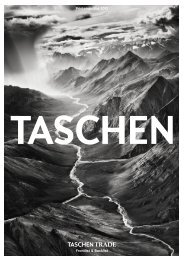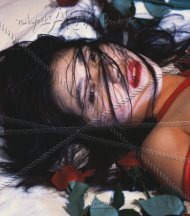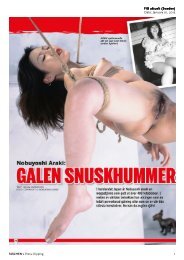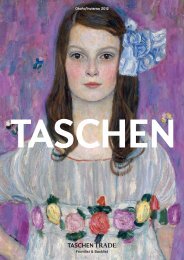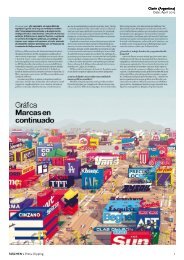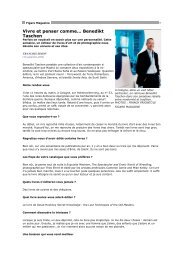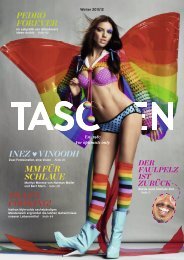Download Clipping (PDF, 0.02 MB) - Taschen
Download Clipping (PDF, 0.02 MB) - Taschen
Download Clipping (PDF, 0.02 MB) - Taschen
Create successful ePaper yourself
Turn your PDF publications into a flip-book with our unique Google optimized e-Paper software.
Type. A Visual History of Typefaces and Graphic Styles Vol.1<br />
The Commerical Dispatch (USA)<br />
Date: May 01, 2010 / Circulation: about 50.000<br />
Let us consider the letter A. We must take the simple, three-lined capital A, because the<br />
lowercase a is not only complicated by curvy lines but it also comes in two distinct popular<br />
forms, one with a straight line at the right of the loop and one in which the line curves over<br />
the loop like an umbrella. So, I say, consider the A. Three straight lines, two leaning<br />
together up to a point, and one horizontal connecting their midsections. This is the Platonic<br />
A, the essence, and you’d know it anywhere. But if you start looking at the huge number of<br />
examples of A (and every other letter) in Type: A Visual History of Typefaces and Graphic<br />
Styles, Volume I, 1628-1900 (<strong>Taschen</strong>), you may get the idea that that exemplar A can’t really<br />
stand for much because there are too many variables. There are some letters A that have no<br />
straight lines (or are made up of flowers, or cartoons of heads), there are plenty that have no<br />
pointy top, there are lots that have more than three lines to them (it would take 20 th century<br />
fonts to produce letters A with less than three lines), and so on. The book is edited by Cees<br />
W. de Jong, and it features examples of metal type specimens from the collection of the late<br />
Jan Tholenaar. Both these authors have written essays to provide a little context, but it is<br />
very little, compared to the 250 pages of print specimens, handsomely laid out in a big<br />
format on rich paper, between covers of canvas with the title and design stamped into it.<br />
This is a handsome object throughout.<br />
Despite the subtitle, Type is not really a history of type, though in his preface and<br />
introductory essay, de Jong does provide brief context. He concentrates, however, on the<br />
fonts you would find in an ordinary printed book which you would sit down and read. Those<br />
of us who like finding a colophon at the end of the book to tell us about the font used will be<br />
familiar with many of the names in de Jong’s little history, both because they are names of<br />
artists in letters and because their names have been used for subsequent fonts in tribute.<br />
First mentioned is William Caslon, who in 1720 at age 28 produced a fine Roman letter<br />
alphabet. (The serifs he used, as in all fonts before, were a carryover from the flow of writing<br />
with a pen. It is amazing to me that the new, simpler sans serif fonts did not appear in<br />
England until 1816.) In 1754, John Baskerville was 48 when he brought out the first of his<br />
famous typefaces, spacious and formal; Baskerville took special interest in letterforms, of<br />
course, but also in ink and paper. Giambattista Boldoni produced a collection of 665<br />
different alphabets, published in 1818 after his death; there are over 500 fonts bearing in<br />
tribute Boldoni as part of their names. An acquaintance of Boldoni said, “In the evenings,<br />
conversing with his friends and in distinguished company, during meals, he was always busy<br />
with his typefaces, justifying a matrix, filing a die, designing a capital.” My preferred font for<br />
typing on the computer, Times New Roman, was produced by Stanley Ignatius Arthur<br />
Morison in 1931, for the London Times after the paper’s manager heard that Morison “had<br />
made scathing remarks about the paper’s outdated typography.” De Jong’s history ends<br />
with Max Miedinger’s Helvetica which was produced in 1960 and filled a huge need for a<br />
subdued san serif typeface. It is also the only font that has had a documentary film<br />
dedicated to it (and it’s a good movie!). De Jong asks, “The question is, has the ideal<br />
typeface been invented yet?” He doesn’t give the answer, but I will: Yes, countless times;<br />
and No, because there will always be attempts at new ones.<br />
When Caslon developed his fonts, for Roman letters and also for Hebrew, Arabic, Greek, and<br />
more, he printed sample sheets so printers could see and evaluate his work. The practice of<br />
TASCHEN's Press <strong>Clipping</strong> 1
The Commerical Dispatch (USA)<br />
Date: May 01, 2010 / Circulation: about 50.000<br />
sending sample fonts in specimen books continued, and such books are what Jan Tholenaar<br />
used to collect. Reproductions from those pages form the bulk of Type. You know how<br />
Victorian décor for houses involved cramming lots of things into a room, things that had<br />
sometimes outrageous layers of decorative detail; it is fun to see that the same sort of<br />
exuberance is all over the pages here. After all, these are really only pages of catalogues,<br />
specialist catalogues for printers representing the narrowest of niche marketing, but they are<br />
astonishingly full of invention and brash showing-off. Such displays befit the period, and<br />
naturally the often anonymous artists who designed the decorative letters and flourishes<br />
shown here wanted to push limits. Besides letters, there are vignettes, a word which I know<br />
to mean “a little picture” or “a small description,” but which before such meanings<br />
designated for the world of printers an ornamental design used to separate chapters or other<br />
divisions in a book, or a picture on the page unenclosed in a border. (The authors do not<br />
refer to “dingbats”, which was a term of derision before printers began using it to mean a bit<br />
of ornamental type.)<br />
The majority of letters here are display types, meant not for the ease of reading which<br />
Boldoni and Baskerville had in mind, but for amusement and show. Many would have been<br />
at home in circus posters, for instance. There are “black letter” faces that were used for<br />
things like newspaper mastheads, and even black letters that seem to be three dimensional.<br />
There are many experiments with three dimensions, with letters seemingly viewed from<br />
above, below, or to the side, sticking out from the page, or sticking into the page, or on long<br />
banners with one wave for each letter. There are calligraphic letters (and plenty of curlicue<br />
vignettes), and stencil forms, and letters that look as if they came from illuminated<br />
manuscripts, and many letters made of flowers. Some letters are populated by cupids, and<br />
some are held up by caryatids. There are letters of stripes vertical, horizontal, and diagonal,<br />
there is hatchwork, there are letters that seem to be puzzles that you have to work hard to<br />
understand. Sometimes full advertisements are reproduced, but often the letters are set in<br />
random words on a page, producing a sort of Dadaist poetry; every word on one of the pages<br />
here is in a completely different style, and the page reads:<br />
COMET MATURE<br />
MIST HOSE<br />
BARN DIMES<br />
HER MEN<br />
NILE KINE<br />
There are borders made out of flowers or abstract flourishes, or ones that look like bits of<br />
architecture, machinery, or draperies. There are pages of vignettes devoted to horses, to<br />
jesters, to clothing, to hands pointing left and to hands pointing right. Purchasers of this<br />
book might miss one of its most attractive assets. Sealed into the back cover is a “key card”<br />
with a password that will allow you to go to <strong>Taschen</strong>’s website, where are archived over a<br />
thousand high-resolution scans of specimens in the book, and they are “downloadable for<br />
unrestricted use.” The pages, and the website, ought to be particularly appreciated by those<br />
who work in printing and design, but are intoxicating even for those of us who just like<br />
seeing fancy letters beautifully presented.<br />
Rob Hardy<br />
TASCHEN's Press <strong>Clipping</strong> 2



